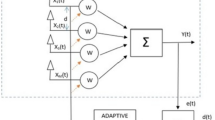Abstract
Blind identification-blind equalization for Finite Impulse Response (FIR) Multiple Input-Multiple Output (MIMO) channels can be reformulated as the problem of blind sources separation. It has been shown that blind identification via decorrelating sub-channels method could recover the input sources. The Blind Identification via Decorrelating Sub-channels(BIDS) algorithm first constructs a set of decorrelators, which decorrelate the output signals of subchannels, and then estimates the channel matrix using the transfer functions of the decorrelators and finally recovers the input signal using the estimated channel matrix. In this paper, a new approximation of the input source for FIR-MIMO channels based on the maximum likelihood source separation method is proposed. The proposed method outperforms BIDS in the presence of additive white Gaussian noise.
Similar content being viewed by others
References
Alexei Gorokhov, Loubaton Philippe, Subspace-based techniques for blind separation of convolutive mixtures with temporally correlated sources, IEEE Trans. on Circuits and Systems-I, 44(1997)9, 813–820.
Chor Tin Ma, Zhi Ding, Sze Fong Yau, A two-stage algorithm for MIMO blind decovolution of colored input signals, IEEE Trans. on Signal Processing, 48(2000)4, 1187–1192.
Ulf Lindgren, Holger Broman, Source separation using a criterion based on second-order statistics, IEEE Trans. on Signal Processing, 46(1998)7, 1837–1850.
Konstantinos Diamantaras, Athina Petropulu, Binning Chen, Blind two-input-two-output FIR channel identification based on second-order statistics, IEEE Trans on Signal Processing, 48(2000)2, 534–542.
Lang Tong, Guangham Xu, K. Thomas, Blind identification and equalization based on second-order statistics: A time domain approach, IEEE Trans. on Info. Theory, 40(1994)3, 340–349.
Yingbo Hua, Yong Xiang, Karim Abed-Merain, Blind identification of colored signals distorted by FIR channels, Proc of the IEEE ICSSP’2000, Istanbul, Turkey, June 2000.
G. Houcem, A. Phillip, D. Jean-Pierre, On the blind (non) identifiability of dispersive band limited channels, (2001 IEEE link) Institut National des Telecommunications, France, April 2001, 2061–2064.
Yingbo Hua, Senjian An, Yong Xiang, Blind identification and equalization of FIR-MIMO Channels by BIDS, ICASSP, April 2001, 2157–2160.
Yingbo Hua, J. Tugnait, Blind identifiability of FIR-MIMO systems with colored input using second order statistics, IEEE Signal Processing Letters, 7(2000)12, 348–350.
Yingbo Hua, Senjian An, Yong Xiang, Blind identification and equalization of FIR-MIMO driven by colored signals, IEEE (link) Trans. on Signal Processing, (2000)9, 2157–2160.
L. Q. Zhang, A. Cichocki, S. Amaris, Natural gradient algorithm for blind separation of over-determined mixtures with additive noise, IEEE Signal Processing letters, 6(1999)11, 293–295.
Author information
Authors and Affiliations
Additional information
Supported by the National Natural Science Foundation of China (No.60172048)
About this article
Cite this article
Takpaya, K., Wei, G. Maximum likelihood source separation for finite impulse response multiple input-multiple output channels in the presence of additive noise. J. of Electron.(China) 20, 81–85 (2003). https://doi.org/10.1007/s11767-003-0001-2
Received:
Revised:
Issue Date:
DOI: https://doi.org/10.1007/s11767-003-0001-2




